info = Data.get_kinase_info()Plot
Setup
Utils
set_sns
set_sns (dpi=300)
Set seaborn resolution for notebook display
save_svg
save_svg (path)
save_pdf
save_pdf (path)
save_show
save_show (path=None, show_only=False)
Show plot or save path
| Type | Default | Details | |
|---|---|---|---|
| path | NoneType | None | image path, e.g., img.svg, if not None, will save, else plt.show() |
| show_only | bool | False |
Color/palette
get_color_dict
get_color_dict (categories, palette:str='tab20')
Assign colors to a list of names (allow duplicates), returns a dictionary of unique name with corresponding color
| Type | Default | Details | |
|---|---|---|---|
| categories | list of names to assign color | ||
| palette | str | tab20 | choose from sns.color_palette |
info.modi_group.value_counts().indexIndex(['TK', 'CAMK', 'Other', 'CMGC', 'AGC', 'STE', 'TKL', 'Atypical', 'CK1',
'NEK', 'RGC'],
dtype='object', name='modi_group')info.pspa_category_big.str.split('_').str[0].value_counts()[:20].indexIndex(['Basophilic', 'Pro-directed', 'Acidophilic', 'Map3k', 'Map4k',
'Alpha/mlk', 'Fgf and vegf receptors', 'Assorted', 'Ripk/wnk', 'Pkc',
'Ephrin receptors', 'Eif2ak/tlk', 'Nek/ask', 'Pdgf receptors', 'Src',
'Jak', 'Tam receptors', 'Cmgc', 'Tec', 'Ulk/ttbk'],
dtype='object', name='pspa_category_big')get_subfamily_color
get_subfamily_color ()
# get_subfamily_color()Sometimes plot functions do not take dict of colors but list of colors:
get_plt_color
get_plt_color (palette, columns)
Given a dict, list or set name, return the list of names; if dict, need to provide column names of the df.
| Details | |
|---|---|
| palette | dict, list, or set name (tab10) |
| columns | columns in the df for plot |
get_plt_color('Set2',['a','b'])get_hue_big
get_hue_big (df, hue_col, cnt_thr=10)
Get part of hue according to its value counts; applied when the groups are too many.
| Type | Default | Details | |
|---|---|---|---|
| df | |||
| hue_col | column of hue | ||
| cnt_thr | int | 10 | higher or equal to this threshold will be considered |
When the categories are too many to show on the plot, we can filter and only show those big categories:
hue_big=get_hue_big(info,'pspa_category_big',10)
hue_big5 Acidophilic
6 Acidophilic
11 Basophilic
12 Basophilic
13 Basophilic
...
516 Acidophilic
517 Acidophilic
519 Map4k
520 Map3k
521 Map3k
Name: pspa_category_big, Length: 294, dtype: object# plot_2d(embed,hue=hue_pspa,hue_title='PSPA category',palette='tab20')Dimensionality reduction
reduce_feature
reduce_feature (df:pandas.core.frame.DataFrame, method:str='pca', complexity:int=20, n:int=2, load:str=None, save:str=None, seed:int=123, **kwargs)
Reduce the dimensionality given a dataframe of values
| Type | Default | Details | |
|---|---|---|---|
| df | DataFrame | ||
| method | str | pca | dimensionality reduction method, accept both capital and lower case |
| complexity | int | 20 | None for PCA; perfplexity for TSNE, recommend: 30; n_neigbors for UMAP, recommend: 15 |
| n | int | 2 | n_components |
| load | str | None | load a previous model, e.g. model.pkl |
| save | str | None | pkl file to be saved, e.g. pca_model.pkl |
| seed | int | 123 | seed for random_state |
| kwargs | VAR_KEYWORD |
A very common way to reduce feature number is to use dimensionality reduction method. reduce_feature is a dimensionality reduction function that can apply three dimensionality reduction methods: PCA, UMAP, TSNE. The later two is non-linear transformation, and PCA is linear transformation. Therefore, for plotting purpose, it is good to use UMAP/TSNE, by setting n (n_components) to 2 for 2d plot; for featuring purpose, it is good to use PCA, and set n to values to a rational values, like 64, 128 etc.
# Load data
df=Data.get_aa_morgan()
# Use PCA to reduce dimension; reduce the number of features to 20
feat = reduce_feature(df,'pca',n=2)
feat.head()| PCA1 | PCA2 | |
|---|---|---|
| aa | ||
| A | -0.954819 | -0.953761 |
| C | -0.041108 | 0.205091 |
| D | -0.087707 | 0.245634 |
| E | -0.271097 | 1.023801 |
| F | 2.253264 | -0.251185 |
2D scatter plot
plot_2d
plot_2d (embedding_df:pandas.core.frame.DataFrame, hue:str=None, complexity:int=30, palette:str='tab20', legend:bool=False, name_list=None, seed:int=123, s:int=20, legend_title:str=None, **kwargs)
Given a dataframe of values, plot it in 2D. The method could be ‘pca’, ‘tsne’, or ‘umap’.
| Type | Default | Details | |
|---|---|---|---|
| embedding_df | DataFrame | a dataframe of values that is waited for dimensionality reduction | |
| hue | str | None | colname of color |
| complexity | int | 30 | this argument does not affect pca but others; recommend 30 for tsne, 15 for umap |
| palette | str | tab20 | color scheme, could be tab10 if less categories |
| legend | bool | False | whether or not add the legend on the side |
| name_list | NoneType | None | a list of names to annotate each dot in the plot |
| seed | int | 123 | seed for dimensionality reduction |
| s | int | 20 | size of the dot |
| legend_title | str | None | new argument to override legend title |
| kwargs | VAR_KEYWORD |
plot_2d(feat)/tmp/ipykernel_8124/600276515.py:20: UserWarning: Ignoring `palette` because no `hue` variable has been assigned.
g = sns.relplot(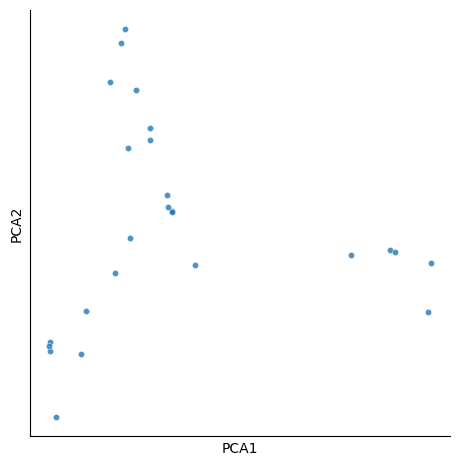
Dimensionality reduction + 2d plot
plot_cluster
plot_cluster (df:pandas.core.frame.DataFrame, method:str='pca', hue:str=None, complexity:int=30, palette:str='tab20', legend:bool=False, name_list=None, seed:int=123, s:int=50, legend_title:str=None, **kwargs)
Given a dataframe of values, plot it in 2D. The method could be ‘pca’, ‘tsne’, or ‘umap’.
| Type | Default | Details | |
|---|---|---|---|
| df | DataFrame | a dataframe of values that is waited for dimensionality reduction | |
| method | str | pca | dimensionality reduction method, choose from pca, umap, and tsne |
| hue | str | None | colname of color |
| complexity | int | 30 | this argument does not affect pca but others; recommend 30 for tsne, 15 for umap |
| palette | str | tab20 | color scheme, could be tab10 if less categories |
| legend | bool | False | whether or not add the legend on the side |
| name_list | NoneType | None | a list of names to annotate each dot in the plot |
| seed | int | 123 | seed for dimensionality reduction |
| s | int | 50 | size of the dot |
| legend_title | str | None | new argument to override legend title |
| kwargs | VAR_KEYWORD |
plot_cluster(df,method='pca',legend=True)/tmp/ipykernel_8124/1814290957.py:23: UserWarning: Ignoring `palette` because no `hue` variable has been assigned.
g = sns.relplot(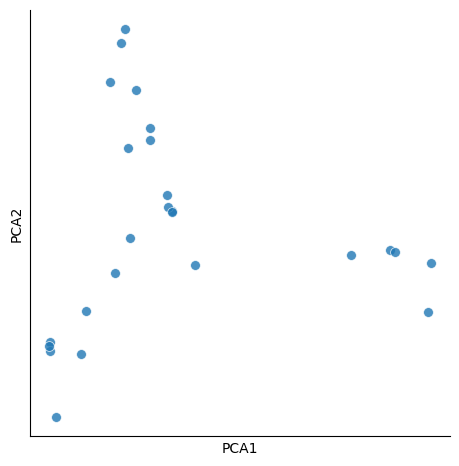
Bokeh interactive plot
plot_bokeh
plot_bokeh (X:pandas.core.frame.DataFrame, idx, hue:None, s:int=3, **kwargs)
Make interactive 2D plot with a searching box and window of dot information when pointing
| Type | Default | Details | |
|---|---|---|---|
| X | DataFrame | a dataframe of two columns from dimensionality reduction | |
| idx | pd.Series or list that indicates identities for searching box | ||
| hue | None | pd.Series or list that indicates category for each sample | |
| s | int | 3 | dot size |
| kwargs | VAR_KEYWORD |
Rank
/opt/hostedtoolcache/Python/3.10.19/x64/lib/python3.10/site-packages/fastcore/docscrape.py:230: UserWarning: Unknown section See Also
else: warn(msg)plot_rank
plot_rank (sorted_df:pandas.core.frame.DataFrame, x:str, y:str, n_hi:int=10, n_lo:int=10, figsize:tuple=(10, 8), data=None, hue=None, size=None, style=None, palette=None, hue_order=None, hue_norm=None, sizes=None, size_order=None, size_norm=None, markers=True, style_order=None, legend='auto', ax=None)
Plot rank from a sorted dataframe
| Type | Default | Details | |
|---|---|---|---|
| sorted_df | DataFrame | a sorted dataframe | |
| x | str | column name for x axis | |
| y | str | column name for y aixs | |
| n_hi | int | 10 | if not None, show the head n names |
| n_lo | int | 10 | if not None, show the tail n names |
| figsize | tuple | (10, 8) | figure size |
| data | NoneType | None | Input data structure. Either a long-form collection of vectors that can be assigned to named variables or a wide-form dataset that will be internally reshaped. |
| hue | NoneType | None | Grouping variable that will produce points with different colors. Can be either categorical or numeric, although color mapping will behave differently in latter case. |
| size | NoneType | None | Grouping variable that will produce points with different sizes. Can be either categorical or numeric, although size mapping will behave differently in latter case. |
| style | NoneType | None | Grouping variable that will produce points with different markers. Can have a numeric dtype but will always be treated as categorical. |
| palette | NoneType | None | Method for choosing the colors to use when mapping the hue semantic.String values are passed to :func: color_palette. List or dict valuesimply categorical mapping, while a colormap object implies numeric mapping. |
| hue_order | NoneType | None | Specify the order of processing and plotting for categorical levels of thehue semantic. |
| hue_norm | NoneType | None | Either a pair of values that set the normalization range in data units or an object that will map from data units into a [0, 1] interval. Usage implies numeric mapping. |
| sizes | NoneType | None | An object that determines how sizes are chosen when size is used.List or dict arguments should provide a size for each unique data value, which forces a categorical interpretation. The argument may also be a min, max tuple. |
| size_order | NoneType | None | Specified order for appearance of the size variable levels,otherwise they are determined from the data. Not relevant when the size variable is numeric. |
| size_norm | NoneType | None | Normalization in data units for scaling plot objects when thesize variable is numeric. |
| markers | bool | True | Object determining how to draw the markers for different levels of thestyle variable. Setting to True will use default markers, oryou can pass a list of markers or a dictionary mapping levels of the style variable to markers. Setting to False will drawmarker-less lines. Markers are specified as in matplotlib. |
| style_order | NoneType | None | Specified order for appearance of the style variable levelsotherwise they are determined from the data. Not relevant when the style variable is numeric. |
| legend | str | auto | How to draw the legend. If “brief”, numeric hue and sizevariables will be represented with a sample of evenly spaced values. If “full”, every group will get an entry in the legend. If “auto”, choose between brief or full representation based on number of levels. If False, no legend data is added and no legend is drawn. |
| ax | NoneType | None | Pre-existing axes for the plot. Otherwise, call :func:matplotlib.pyplot.gcainternally. |
| Returns | :class:matplotlib.axes.Axes |
The matplotlib axes containing the plot. |
# load data
# df = Data.get_pspa_raw().set_index('kinase')
df = pd.read_csv('https://github.com/sky1ove/katlas_raw/raw/refs/heads/main/nbs/raw/pspa_st_raw.csv').set_index('kinase')
# get sorted dataframe
sorted_df = df.max(1).reset_index(name='values').sort_values('values')
sorted_df.head()| kinase | values | |
|---|---|---|
| 68 | CK1G2 | 189898.392 |
| 294 | VRK2 | 4191709.640 |
| 8 | ALPHAK3 | 4573611.730 |
| 249 | PRPK | 8495330.790 |
| 38 | CAMLCK | 9413689.600 |
plot_rank(sorted_df,x='kinase',y='values')
plt.xlabel('kinase');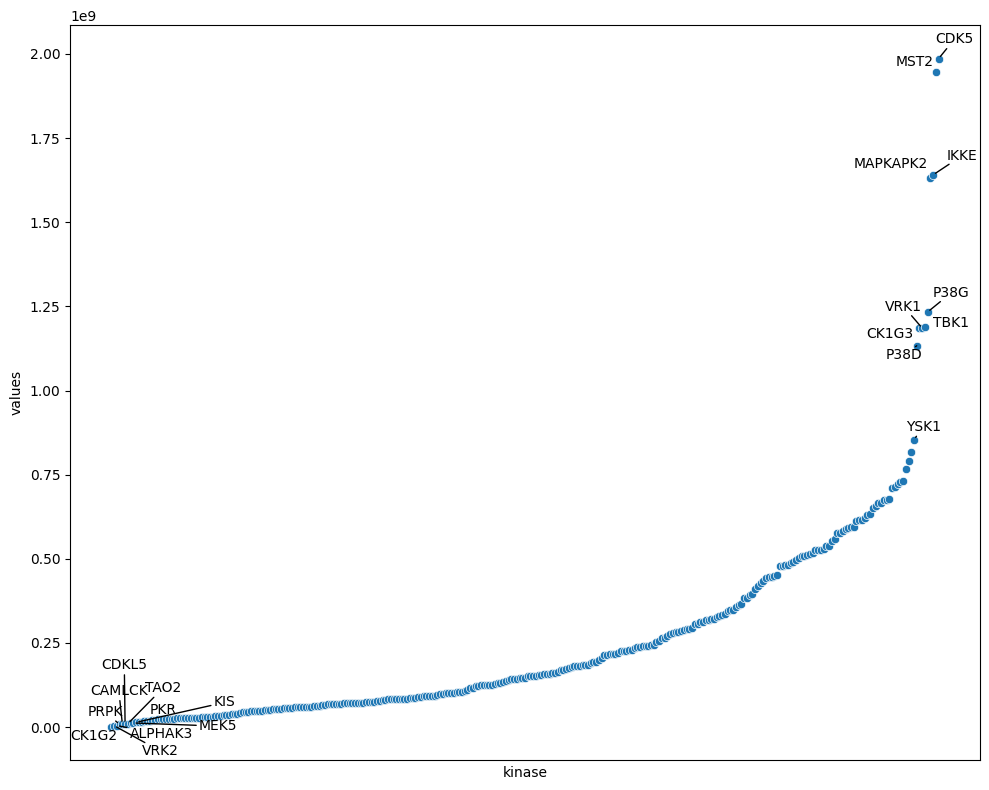
Distribution histogram
plot_hist
plot_hist (df:pandas.core.frame.DataFrame, x:str, figsize:tuple=(6, 2), data=None, y=None, hue=None, weights=None, stat='count', bins='auto', binwidth=None, binrange=None, discrete=None, cumulative=False, common_bins=True, common_norm=True, multiple='layer', element='bars', fill=True, shrink=1, kde=False, kde_kws=None, line_kws=None, thresh=0, pthresh=None, pmax=None, cbar=False, cbar_ax=None, cbar_kws=None, palette=None, hue_order=None, hue_norm=None, color=None, log_scale=None, legend=True, ax=None)
| Type | Default | Details | |
|---|---|---|---|
| df | DataFrame | a dataframe that contain values for plot | |
| x | str | column name of values | |
| figsize | tuple | (6, 2) | |
| data | NoneType | None | Input data structure. Either a long-form collection of vectors that can be assigned to named variables or a wide-form dataset that will be internally reshaped. |
| y | NoneType | None | |
| hue | NoneType | None | Semantic variable that is mapped to determine the color of plot elements. |
| weights | NoneType | None | Vector variables |
| stat | str | count | Aggregate statistic to compute in each bin. - count: show the number of observations in each bin- frequency: show the number of observations divided by the bin width- probability or proportion: normalize such that bar heights sum to 1- percent: normalize such that bar heights sum to 100- density: normalize such that the total area of the histogram equals 1 |
| bins | str | auto | Generic bin parameter that can be the name of a reference rule, the number of bins, or the breaks of the bins. Passed to :func: numpy.histogram_bin_edges. |
| binwidth | NoneType | None | Width of each bin, overrides bins but can be used withbinrange. |
| binrange | NoneType | None | Histogram computation parameters |
| discrete | NoneType | None | If True, default to binwidth=1 and draw the bars so that they arecentered on their corresponding data points. This avoids “gaps” that may otherwise appear when using discrete (integer) data. |
| cumulative | bool | False | If True, plot the cumulative counts as bins increase. |
| common_bins | bool | True | If True, use the same bins when semantic variables produce multiple plots. If using a reference rule to determine the bins, it will be computed with the full dataset. |
| common_norm | bool | True | If True and using a normalized statistic, the normalization will apply over the full dataset. Otherwise, normalize each histogram independently. |
| multiple | str | layer | Approach to resolving multiple elements when semantic mapping creates subsets. Only relevant with univariate data. |
| element | str | bars | Visual representation of the histogram statistic. Only relevant with univariate data. |
| fill | bool | True | If True, fill in the space under the histogram. Only relevant with univariate data. |
| shrink | int | 1 | Histogram appearance parameters |
| kde | bool | False | If True, compute a kernel density estimate to smooth the distribution and show on the plot as (one or more) line(s). Only relevant with univariate data. |
| kde_kws | NoneType | None | Parameters that control the KDE computation, as in :func:kdeplot. |
| line_kws | NoneType | None | Histogram smoothing with a kernel density estimate |
| thresh | int | 0 | Cells with a statistic less than or equal to this value will be transparent. Only relevant with bivariate data. |
| pthresh | NoneType | None | Like thresh, but a value in [0, 1] such that cells with aggregate counts(or other statistics, when used) up to this proportion of the total will be transparent. |
| pmax | NoneType | None | A value in [0, 1] that sets that saturation point for the colormap at a value such that cells below constitute this proportion of the total count (or other statistic, when used). |
| cbar | bool | False | If True, add a colorbar to annotate the color mapping in a bivariate plot. Note: Does not currently support plots with a hue variable well. |
| cbar_ax | NoneType | None | Pre-existing axes for the colorbar. |
| cbar_kws | NoneType | None | Bivariate histogram parameters |
| palette | NoneType | None | Method for choosing the colors to use when mapping the hue semantic.String values are passed to :func: color_palette. List or dict valuesimply categorical mapping, while a colormap object implies numeric mapping. |
| hue_order | NoneType | None | Specify the order of processing and plotting for categorical levels of thehue semantic. |
| hue_norm | NoneType | None | Either a pair of values that set the normalization range in data units or an object that will map from data units into a [0, 1] interval. Usage implies numeric mapping. |
| color | NoneType | None | Hue mapping parameters |
| log_scale | NoneType | None | Set axis scale(s) to log. A single value sets the data axis for any numeric axes in the plot. A pair of values sets each axis independently. Numeric values are interpreted as the desired base (default 10). When None or False, seaborn defers to the existing Axes scale. |
| legend | bool | True | If False, suppress the legend for semantic variables. |
| ax | NoneType | None | Axes information |
| Returns | :class:matplotlib.axes.Axes |
The matplotlib axes containing the plot. |
# we can use the same df
sorted_df.head()| kinase | values | |
|---|---|---|
| 68 | CK1G2 | 189898.392 |
| 294 | VRK2 | 4191709.640 |
| 8 | ALPHAK3 | 4573611.730 |
| 249 | PRPK | 8495330.790 |
| 38 | CAMLCK | 9413689.600 |
plot_hist(sorted_df,'values')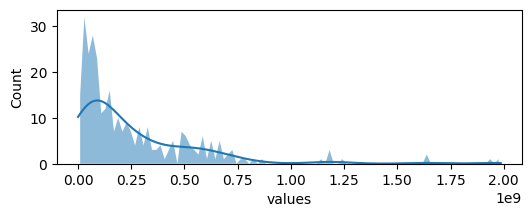
Bar graph
plot_count
plot_count (cnt, tick_spacing:float=None, palette:str='tab20')
Make bar plot from df[‘x’].value_counts()
| Type | Default | Details | |
|---|---|---|---|
| cnt | from df[‘x’].value_counts() | ||
| tick_spacing | float | None | tick spacing for x axis |
| palette | str | tab20 |
cnt = info.Name.value_counts()plot_count(cnt)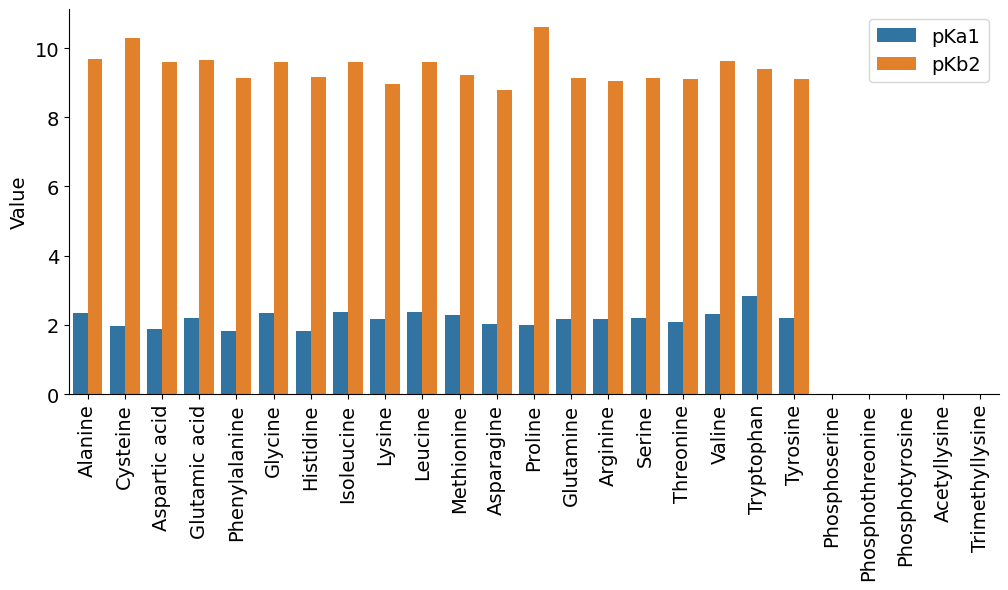
plot_bar
plot_bar (df, value, group, title=None, figsize=(12, 5), fontsize=14, dots=True, rotation=90, ascending=False, ymin=None, data=None, x=None, y=None, hue=None, order=None, hue_order=None, estimator='mean', errorbar=('ci', 95), n_boot=1000, seed=None, units=None, weights=None, orient=None, color=None, palette=None, saturation=0.75, fill=True, hue_norm=None, width=0.8, dodge='auto', gap=0, log_scale=None, native_scale=False, formatter=None, legend='auto', capsize=0, err_kws=None, ci=<deprecated>, errcolor=<deprecated>, errwidth=<deprecated>, ax=None)
Plot bar graph from unstacked dataframe; need to indicate columns of values and categories
| Type | Default | Details | |
|---|---|---|---|
| df | |||
| value | colname of value | ||
| group | colname of group | ||
| title | NoneType | None | |
| figsize | tuple | (12, 5) | |
| fontsize | int | 14 | |
| dots | bool | True | whether or not add dots in the graph |
| rotation | int | 90 | |
| ascending | bool | False | |
| ymin | NoneType | None | |
| data | NoneType | None | Dataset for plotting. If x and y are absent, this isinterpreted as wide-form. Otherwise it is expected to be long-form. |
| x | NoneType | None | |
| y | NoneType | None | |
| hue | NoneType | None | |
| order | NoneType | None | |
| hue_order | NoneType | None | |
| estimator | str | mean | Statistical function to estimate within each categorical bin. |
| errorbar | tuple | (‘ci’, 95) | Name of errorbar method (either “ci”, “pi”, “se”, or “sd”), or a tuple with a method name and a level parameter, or a function that maps from a vector to a (min, max) interval, or None to hide errorbar. See the :doc: errorbar tutorial </tutorial/error_bars> for more information... versionadded:: v0.12.0 |
| n_boot | int | 1000 | Number of bootstrap samples used to compute confidence intervals. |
| seed | NoneType | None | Seed or random number generator for reproducible bootstrapping. |
| units | NoneType | None | Identifier of sampling units; used by the errorbar function to perform a multilevel bootstrap and account for repeated measures |
| weights | NoneType | None | Data values or column used to compute weighted statistics. Note that the use of weights may limit other statistical options. .. versionadded:: v0.13.1 |
| orient | NoneType | None | Orientation of the plot (vertical or horizontal). This is usually inferred based on the type of the input variables, but it can be used to resolve ambiguity when both x and y are numeric or whenplotting wide-form data. .. versionchanged:: v0.13.0 Added ‘x’/‘y’ as options, equivalent to ‘v’/‘h’. |
| color | NoneType | None | Single color for the elements in the plot. |
| palette | NoneType | None | Colors to use for the different levels of the hue variable. Shouldbe something that can be interpreted by :func: color_palette, or adictionary mapping hue levels to matplotlib colors. |
| saturation | float | 0.75 | Proportion of the original saturation to draw fill colors in. Large patches often look better with desaturated colors, but set this to 1 if you want the colors to perfectly match the input values. |
| fill | bool | True | If True, use a solid patch. Otherwise, draw as line art. .. versionadded:: v0.13.0 |
| hue_norm | NoneType | None | Normalization in data units for colormap applied to the huevariable when it is numeric. Not relevant if hue is categorical... versionadded:: v0.12.0 |
| width | float | 0.8 | Width allotted to each element on the orient axis. When native_scale=True,it is relative to the minimum distance between two values in the native scale. |
| dodge | str | auto | When hue mapping is used, whether elements should be narrowed and shifted along the orient axis to eliminate overlap. If "auto", set to True when theorient variable is crossed with the categorical variable or False otherwise... versionchanged:: 0.13.0 Added "auto" mode as a new default. |
| gap | int | 0 | Shrink on the orient axis by this factor to add a gap between dodged elements. .. versionadded:: 0.13.0 |
| log_scale | NoneType | None | Set axis scale(s) to log. A single value sets the data axis for any numeric axes in the plot. A pair of values sets each axis independently. Numeric values are interpreted as the desired base (default 10). When None or False, seaborn defers to the existing Axes scale... versionadded:: v0.13.0 |
| native_scale | bool | False | When True, numeric or datetime values on the categorical axis will maintain their original scaling rather than being converted to fixed indices. .. versionadded:: v0.13.0 |
| formatter | NoneType | None | Function for converting categorical data into strings. Affects both grouping and tick labels. .. versionadded:: v0.13.0 |
| legend | str | auto | How to draw the legend. If “brief”, numeric hue and sizevariables will be represented with a sample of evenly spaced values. If “full”, every group will get an entry in the legend. If “auto”, choose between brief or full representation based on number of levels. If False, no legend data is added and no legend is drawn... versionadded:: v0.13.0 |
| capsize | int | 0 | Width of the “caps” on error bars, relative to bar spacing. |
| err_kws | NoneType | None | Parameters of :class:matplotlib.lines.Line2D, for the error bar artists... versionadded:: v0.13.0 |
| ci | Deprecated | Level of the confidence interval to show, in [0, 100]. .. deprecated:: v0.12.0 Use errorbar=("ci", ...). |
|
| errcolor | Deprecated | Color used for the error bar lines. .. deprecated:: 0.13.0 Use err_kws={'color': ...}. |
|
| errwidth | Deprecated | Thickness of error bar lines (and caps), in points. .. deprecated:: 0.13.0 Use err_kws={'linewidth': ...}. |
|
| ax | NoneType | None | Axes object to draw the plot onto, otherwise uses the current Axes. |
| Returns | matplotlib Axes | Returns the Axes object with the plot drawn onto it. |
info['cat'] = (info.pKa1>2).astype(int)# get an unstacked dataframe
plot_bar(info,value='MW',group='cat',palette='tab20')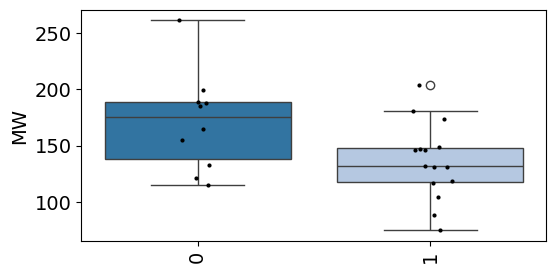
plot_group_bar
plot_group_bar (df, value_cols, group, figsize=(12, 5), order=None, title=None, fontsize=14, rotation=90, data=None, x=None, y=None, hue=None, hue_order=None, estimator='mean', errorbar=('ci', 95), n_boot=1000, seed=None, units=None, weights=None, orient=None, color=None, palette=None, saturation=0.75, fill=True, hue_norm=None, width=0.8, dodge='auto', gap=0, log_scale=None, native_scale=False, formatter=None, legend='auto', capsize=0, err_kws=None, ci=<deprecated>, errcolor=<deprecated>, errwidth=<deprecated>, ax=None)
Plot grouped bar graph from dataframe.
| Type | Default | Details | |
|---|---|---|---|
| df | |||
| value_cols | list of column names for values, the order depends on the first item | ||
| group | column name of group (e.g., ‘kinase’) | ||
| figsize | tuple | (12, 5) | |
| order | NoneType | None | |
| title | NoneType | None | |
| fontsize | int | 14 | |
| rotation | int | 90 | |
| data | NoneType | None | Dataset for plotting. If x and y are absent, this isinterpreted as wide-form. Otherwise it is expected to be long-form. |
| x | NoneType | None | |
| y | NoneType | None | |
| hue | NoneType | None | |
| hue_order | NoneType | None | |
| estimator | str | mean | Statistical function to estimate within each categorical bin. |
| errorbar | tuple | (‘ci’, 95) | Name of errorbar method (either “ci”, “pi”, “se”, or “sd”), or a tuple with a method name and a level parameter, or a function that maps from a vector to a (min, max) interval, or None to hide errorbar. See the :doc: errorbar tutorial </tutorial/error_bars> for more information... versionadded:: v0.12.0 |
| n_boot | int | 1000 | Number of bootstrap samples used to compute confidence intervals. |
| seed | NoneType | None | Seed or random number generator for reproducible bootstrapping. |
| units | NoneType | None | Identifier of sampling units; used by the errorbar function to perform a multilevel bootstrap and account for repeated measures |
| weights | NoneType | None | Data values or column used to compute weighted statistics. Note that the use of weights may limit other statistical options. .. versionadded:: v0.13.1 |
| orient | NoneType | None | Orientation of the plot (vertical or horizontal). This is usually inferred based on the type of the input variables, but it can be used to resolve ambiguity when both x and y are numeric or whenplotting wide-form data. .. versionchanged:: v0.13.0 Added ‘x’/‘y’ as options, equivalent to ‘v’/‘h’. |
| color | NoneType | None | Single color for the elements in the plot. |
| palette | NoneType | None | Colors to use for the different levels of the hue variable. Shouldbe something that can be interpreted by :func: color_palette, or adictionary mapping hue levels to matplotlib colors. |
| saturation | float | 0.75 | Proportion of the original saturation to draw fill colors in. Large patches often look better with desaturated colors, but set this to 1 if you want the colors to perfectly match the input values. |
| fill | bool | True | If True, use a solid patch. Otherwise, draw as line art. .. versionadded:: v0.13.0 |
| hue_norm | NoneType | None | Normalization in data units for colormap applied to the huevariable when it is numeric. Not relevant if hue is categorical... versionadded:: v0.12.0 |
| width | float | 0.8 | Width allotted to each element on the orient axis. When native_scale=True,it is relative to the minimum distance between two values in the native scale. |
| dodge | str | auto | When hue mapping is used, whether elements should be narrowed and shifted along the orient axis to eliminate overlap. If "auto", set to True when theorient variable is crossed with the categorical variable or False otherwise... versionchanged:: 0.13.0 Added "auto" mode as a new default. |
| gap | int | 0 | Shrink on the orient axis by this factor to add a gap between dodged elements. .. versionadded:: 0.13.0 |
| log_scale | NoneType | None | Set axis scale(s) to log. A single value sets the data axis for any numeric axes in the plot. A pair of values sets each axis independently. Numeric values are interpreted as the desired base (default 10). When None or False, seaborn defers to the existing Axes scale... versionadded:: v0.13.0 |
| native_scale | bool | False | When True, numeric or datetime values on the categorical axis will maintain their original scaling rather than being converted to fixed indices. .. versionadded:: v0.13.0 |
| formatter | NoneType | None | Function for converting categorical data into strings. Affects both grouping and tick labels. .. versionadded:: v0.13.0 |
| legend | str | auto | How to draw the legend. If “brief”, numeric hue and sizevariables will be represented with a sample of evenly spaced values. If “full”, every group will get an entry in the legend. If “auto”, choose between brief or full representation based on number of levels. If False, no legend data is added and no legend is drawn... versionadded:: v0.13.0 |
| capsize | int | 0 | Width of the “caps” on error bars, relative to bar spacing. |
| err_kws | NoneType | None | Parameters of :class:matplotlib.lines.Line2D, for the error bar artists... versionadded:: v0.13.0 |
| ci | Deprecated | Level of the confidence interval to show, in [0, 100]. .. deprecated:: v0.12.0 Use errorbar=("ci", ...). |
|
| errcolor | Deprecated | Color used for the error bar lines. .. deprecated:: 0.13.0 Use err_kws={'color': ...}. |
|
| errwidth | Deprecated | Thickness of error bar lines (and caps), in points. .. deprecated:: 0.13.0 Use err_kws={'linewidth': ...}. |
|
| ax | NoneType | None | Axes object to draw the plot onto, otherwise uses the current Axes. |
| Returns | matplotlib Axes | Returns the Axes object with the plot drawn onto it. |
plot_group_bar(info,['pKa1','pKb2'],'Name')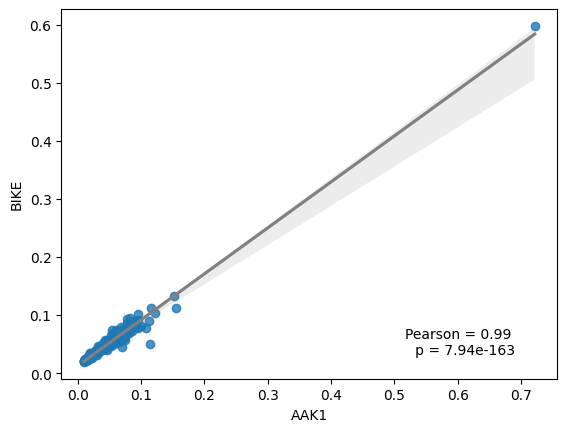
Stacked bar graph
plot_stacked
plot_stacked (df, column, hue, figsize=(5, 4), xlabel=None, ylabel=None, add_value=True, **kwargs)
Violin plot
plot_violin
plot_violin (data, value='value', group='variable', ylabel=None, dots=True, figsize=(5, 3), **kwargs)
Plot violin plots (with optional strip dots) for long-form data.
# plot_violin(data,ylabel='Accuracy',figsize=(4,3))add_stats
add_stats (ax, data, value='value', group='variable', pairs=None, test='t-test_ind', loc='inside', text_format='star', **kwargs)
Box plot
plot_box
plot_box (df, value, group, title=None, figsize=(6, 3), fontsize=14, dots=True, rotation=90, data=None, x=None, y=None, hue=None, order=None, hue_order=None, orient=None, color=None, palette=None, saturation=0.75, fill=True, dodge='auto', width=0.8, gap=0, whis=1.5, linecolor='auto', linewidth=None, fliersize=None, hue_norm=None, native_scale=False, log_scale=None, formatter=None, legend='auto', ax=None)
Plot box plot.
| Type | Default | Details | |
|---|---|---|---|
| df | |||
| value | colname of value | ||
| group | colname of group | ||
| title | NoneType | None | |
| figsize | tuple | (6, 3) | |
| fontsize | int | 14 | |
| dots | bool | True | |
| rotation | int | 90 | |
| data | NoneType | None | Dataset for plotting. If x and y are absent, this isinterpreted as wide-form. Otherwise it is expected to be long-form. |
| x | NoneType | None | |
| y | NoneType | None | |
| hue | NoneType | None | |
| order | NoneType | None | |
| hue_order | NoneType | None | |
| orient | NoneType | None | Orientation of the plot (vertical or horizontal). This is usually inferred based on the type of the input variables, but it can be used to resolve ambiguity when both x and y are numeric or whenplotting wide-form data. .. versionchanged:: v0.13.0 Added ‘x’/‘y’ as options, equivalent to ‘v’/‘h’. |
| color | NoneType | None | Single color for the elements in the plot. |
| palette | NoneType | None | Colors to use for the different levels of the hue variable. Shouldbe something that can be interpreted by :func: color_palette, or adictionary mapping hue levels to matplotlib colors. |
| saturation | float | 0.75 | Proportion of the original saturation to draw fill colors in. Large patches often look better with desaturated colors, but set this to 1 if you want the colors to perfectly match the input values. |
| fill | bool | True | If True, use a solid patch. Otherwise, draw as line art. .. versionadded:: v0.13.0 |
| dodge | str | auto | When hue mapping is used, whether elements should be narrowed and shifted along the orient axis to eliminate overlap. If "auto", set to True when theorient variable is crossed with the categorical variable or False otherwise... versionchanged:: 0.13.0 Added "auto" mode as a new default. |
| width | float | 0.8 | Width allotted to each element on the orient axis. When native_scale=True,it is relative to the minimum distance between two values in the native scale. |
| gap | int | 0 | Shrink on the orient axis by this factor to add a gap between dodged elements. .. versionadded:: 0.13.0 |
| whis | float | 1.5 | Paramater that controls whisker length. If scalar, whiskers are drawn to the farthest datapoint within whis IQR* from the nearest hinge. If a tuple, it is interpreted as percentiles that whiskers represent. |
| linecolor | str | auto | Color to use for line elements, when fill is True... versionadded:: v0.13.0 |
| linewidth | NoneType | None | Width of the lines that frame the plot elements. |
| fliersize | NoneType | None | Size of the markers used to indicate outlier observations. |
| hue_norm | NoneType | None | Normalization in data units for colormap applied to the huevariable when it is numeric. Not relevant if hue is categorical... versionadded:: v0.12.0 |
| native_scale | bool | False | When True, numeric or datetime values on the categorical axis will maintain their original scaling rather than being converted to fixed indices. .. versionadded:: v0.13.0 |
| log_scale | NoneType | None | Set axis scale(s) to log. A single value sets the data axis for any numeric axes in the plot. A pair of values sets each axis independently. Numeric values are interpreted as the desired base (default 10). When None or False, seaborn defers to the existing Axes scale... versionadded:: v0.13.0 |
| formatter | NoneType | None | Function for converting categorical data into strings. Affects both grouping and tick labels. .. versionadded:: v0.13.0 |
| legend | str | auto | How to draw the legend. If “brief”, numeric hue and sizevariables will be represented with a sample of evenly spaced values. If “full”, every group will get an entry in the legend. If “auto”, choose between brief or full representation based on number of levels. If False, no legend data is added and no legend is drawn... versionadded:: v0.13.0 |
| ax | NoneType | None | Axes object to draw the plot onto, otherwise uses the current Axes. |
| Returns | matplotlib Axes | Returns the Axes object with the plot drawn onto it. |
plot_box(info,value='MW',group='cat',palette='tab20')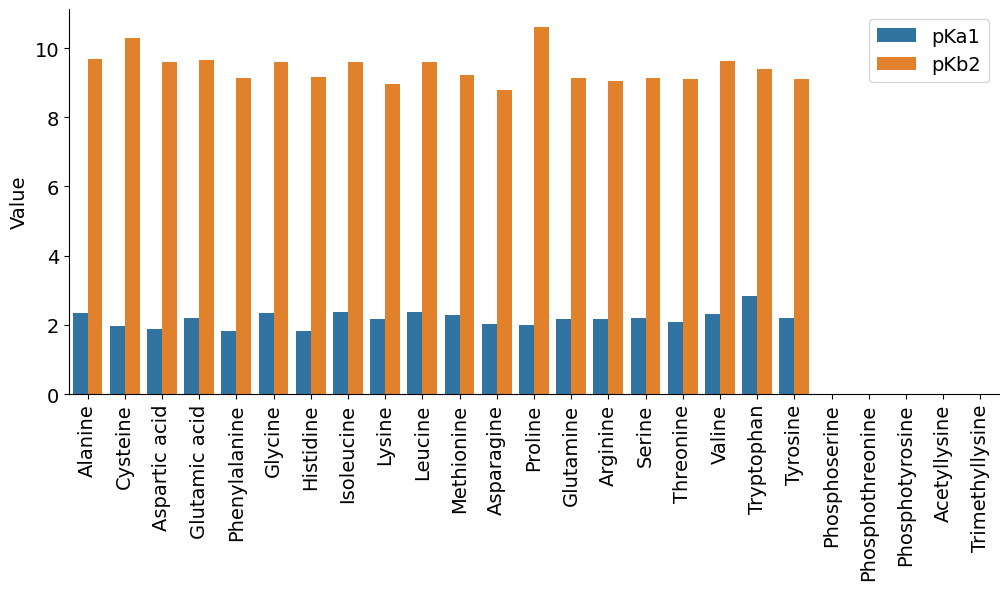
Pearson correlation
plot_rel
plot_rel (df, x, y, text_location=(0.8, 0.1), method='spearman', index_list=None, hue=None, reg_line=True, data=None, x_estimator=None, x_bins=None, x_ci='ci', scatter=True, fit_reg=True, ci=95, n_boot=1000, units=None, seed=None, order=1, logistic=False, lowess=False, robust=False, logx=False, x_partial=None, y_partial=None, truncate=True, dropna=True, x_jitter=None, y_jitter=None, label=None, color=None, marker='o', scatter_kws=None, line_kws=None, ax=None)
Given a dataframe and the name of two columns, plot the two columns’ correlation with either Pearson or Spearman. Annotate points if their index is in index_list.
| Type | Default | Details | |
|---|---|---|---|
| df | dataframe that contains data | ||
| x | x axis values, or colname of x axis | ||
| y | y axis values, or colname of y axis | ||
| text_location | tuple | (0.8, 0.1) | relative coords in Axes (0–1) |
| method | str | spearman | correlation method: ‘pearson’ or ‘spearman’ |
| index_list | NoneType | None | list of indices to annotate |
| hue | NoneType | None | |
| reg_line | bool | True | |
| data | NoneType | None | Tidy (“long-form”) dataframe where each column is a variable and each row is an observation. |
| x_estimator | NoneType | None | Apply this function to each unique value of x and plot theresulting estimate. This is useful when x is a discrete variable.If x_ci is given, this estimate will be bootstrapped and aconfidence interval will be drawn. |
| x_bins | NoneType | None | Bin the x variable into discrete bins and then estimate the centraltendency and a confidence interval. This binning only influences how the scatterplot is drawn; the regression is still fit to the original data. This parameter is interpreted either as the number of evenly-sized (not necessary spaced) bins or the positions of the bin centers. When this parameter is used, it implies that the default of x_estimator is numpy.mean. |
| x_ci | str | ci | Size of the confidence interval used when plotting a central tendency for discrete values of x. If "ci", defer to the value of theci parameter. If "sd", skip bootstrapping and show thestandard deviation of the observations in each bin. |
| scatter | bool | True | If True, draw a scatterplot with the underlying observations (orthe x_estimator values). |
| fit_reg | bool | True | If True, estimate and plot a regression model relating the xand y variables. |
| ci | int | 95 | Size of the confidence interval for the regression estimate. This will be drawn using translucent bands around the regression line. The confidence interval is estimated using a bootstrap; for large datasets, it may be advisable to avoid that computation by setting this parameter to None. |
| n_boot | int | 1000 | Number of bootstrap resamples used to estimate the ci. The defaultvalue attempts to balance time and stability; you may want to increase this value for “final” versions of plots. |
| units | NoneType | None | If the x and y observations are nested within sampling units,those can be specified here. This will be taken into account when computing the confidence intervals by performing a multilevel bootstrap that resamples both units and observations (within unit). This does not otherwise influence how the regression is estimated or drawn. |
| seed | NoneType | None | Seed or random number generator for reproducible bootstrapping. |
| order | int | 1 | If order is greater than 1, use numpy.polyfit to estimate apolynomial regression. |
| logistic | bool | False | If True, assume that y is a binary variable and usestatsmodels to estimate a logistic regression model. Note that thisis substantially more computationally intensive than linear regression, so you may wish to decrease the number of bootstrap resamples ( n_boot) or set ci to None. |
| lowess | bool | False | If True, use statsmodels to estimate a nonparametric lowessmodel (locally weighted linear regression). Note that confidence intervals cannot currently be drawn for this kind of model. |
| robust | bool | False | If True, use statsmodels to estimate a robust regression. Thiswill de-weight outliers. Note that this is substantially more computationally intensive than standard linear regression, so you may wish to decrease the number of bootstrap resamples ( n_boot) or setci to None. |
| logx | bool | False | If True, estimate a linear regression of the form y ~ log(x), butplot the scatterplot and regression model in the input space. Note that x must be positive for this to work. |
| x_partial | NoneType | None | |
| y_partial | NoneType | None | |
| truncate | bool | True | If True, the regression line is bounded by the data limits. IfFalse, it extends to the x axis limits. |
| dropna | bool | True | |
| x_jitter | NoneType | None | |
| y_jitter | NoneType | None | |
| label | NoneType | None | Label to apply to either the scatterplot or regression line (ifscatter is False) for use in a legend. |
| color | NoneType | None | Color to apply to all plot elements; will be superseded by colors passed in scatter_kws or line_kws. |
| marker | str | o | Marker to use for the scatterplot glyphs. |
| scatter_kws | NoneType | None | |
| line_kws | NoneType | None | |
| ax | NoneType | None | Axes object to draw the plot onto, otherwise uses the current Axes. |
| Returns | matplotlib Axes | The Axes object containing the plot. |
norm = Data.get_pspa().iloc[:,:-6].T
norm.head()| kinase | AAK1 | ACVR2A | ACVR2B | AKT1 | AKT2 | AKT3 | ALK2 | ALK4 | ALPHAK3 | AMPKA1 | ... | VRK1 | VRK2 | WNK1 | WNK3 | WNK4 | YANK2 | YANK3 | YSK1 | YSK4 | ZAK |
|---|---|---|---|---|---|---|---|---|---|---|---|---|---|---|---|---|---|---|---|---|---|
| -5P | 0.0720 | 0.0415 | 0.0533 | 0.0603 | 0.0602 | 0.0705 | 0.0536 | 0.0552 | 0.0571 | 0.0555 | ... | 0.0710 | 0.0684 | 0.0482 | 0.0413 | 0.0369 | 0.0580 | 0.0625 | 0.0590 | 0.0593 | 0.0604 |
| -5G | 0.0245 | 0.0481 | 0.0517 | 0.0594 | 0.0617 | 0.0624 | 0.0659 | 0.0574 | 0.0478 | 0.0504 | ... | 0.0786 | 0.0676 | 0.0510 | 0.0572 | 0.0523 | 0.0699 | 0.0776 | 0.0713 | 0.0728 | 0.0641 |
| -5A | 0.0284 | 0.0584 | 0.0566 | 0.0552 | 0.0643 | 0.0745 | 0.0662 | 0.0605 | 0.0253 | 0.0534 | ... | 0.0633 | 0.0636 | 0.0555 | 0.0503 | 0.0539 | 0.0637 | 0.0647 | 0.0731 | 0.0744 | 0.0659 |
| -5C | 0.0456 | 0.0489 | 0.0772 | 0.0605 | 0.0582 | 0.0628 | 0.0762 | 0.0483 | 0.0384 | 0.0588 | ... | 0.0641 | 0.0644 | 0.0576 | 0.0732 | 0.0544 | 0.0602 | 0.0598 | 0.0606 | 0.0734 | 0.0631 |
| -5S | 0.0425 | 0.0578 | 0.0533 | 0.0516 | 0.0534 | 0.0442 | 0.0567 | 0.0574 | 0.0571 | 0.0504 | ... | 0.0595 | 0.0573 | 0.0561 | 0.0569 | 0.0580 | 0.0580 | 0.0545 | 0.0542 | 0.0597 | 0.0597 |
5 rows × 303 columns
plot_rel(df=norm, x='AAK1', y='BIKE')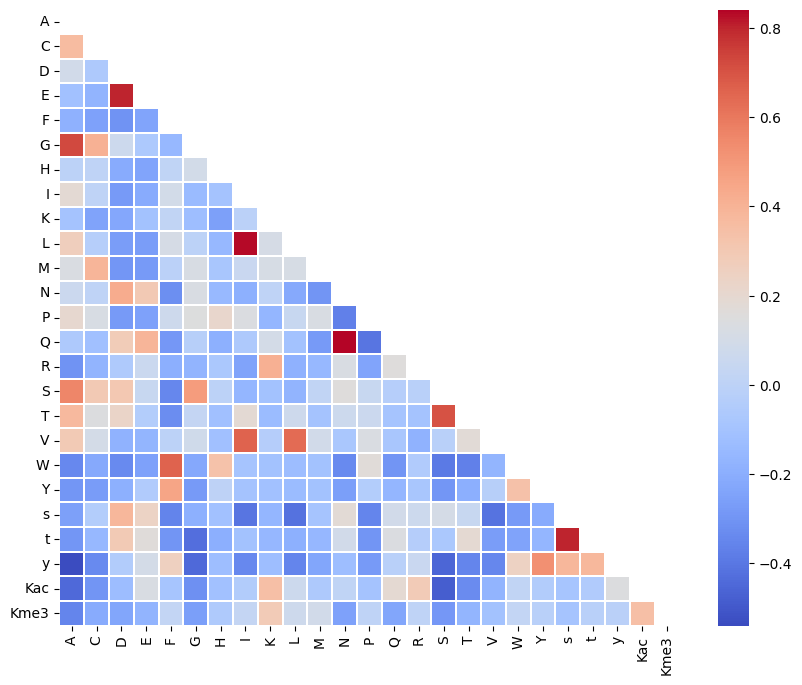
Matrix heatmap
get_similarity
get_similarity (df, metric='euclidean')
Calculate distance matrix of a df; also return inverse df (similarity df)
plot_corr
plot_corr (df_corr, inverse_color=False, figsize=(15, 10), **kwargs)
Plot distance/similarity matrix
corr = info.head(8).corr(numeric_only=True)plot_corr(corr)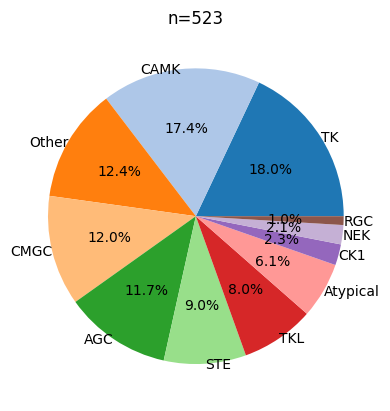
AUCDF
We compute the area under the empirical cumulative distribution function (CDF) as a function of kinase rank using the trapezoidal rule.
Let $ r_{(1)} < r_{(2)} < < r_{(n)} $ be the sorted rank values (e.g., \(1,2,\dots,n\)), and define the empirical CDF values as:
\[ F(r_{(i)}) = \frac{i}{n} \]
The normalized area under this CDF-vs-rank curve (AUCDF) is then computed via the trapezoidal rule:
\[ \text{AUC}_{\text{CDF}} = \frac{1}{r_{\max} - r_{\min}} \sum_{i=1}^{n-1} \frac{F(r_{(i)}) + F(r_{(i+1)})}{2} \cdot (r_{(i+1)} - r_{(i)}) \]
where $ r_{} = r_{(1)} $, typically 1; $ r_{} = r_{(n)} $, typically \(n\).
This measures how quickly the cumulative mass increases across the ranked kinases. If better kinases (lower rank) tend to appear earlier in the CDF, the AUCDF will be higher.
get_AUCDF
get_AUCDF (df, col, reverse=False, plot=True, xlabel='Rank of reported kinase')
Plot CDF curve and get relative area under the curve
get_AUCDF(sorted_df,'values')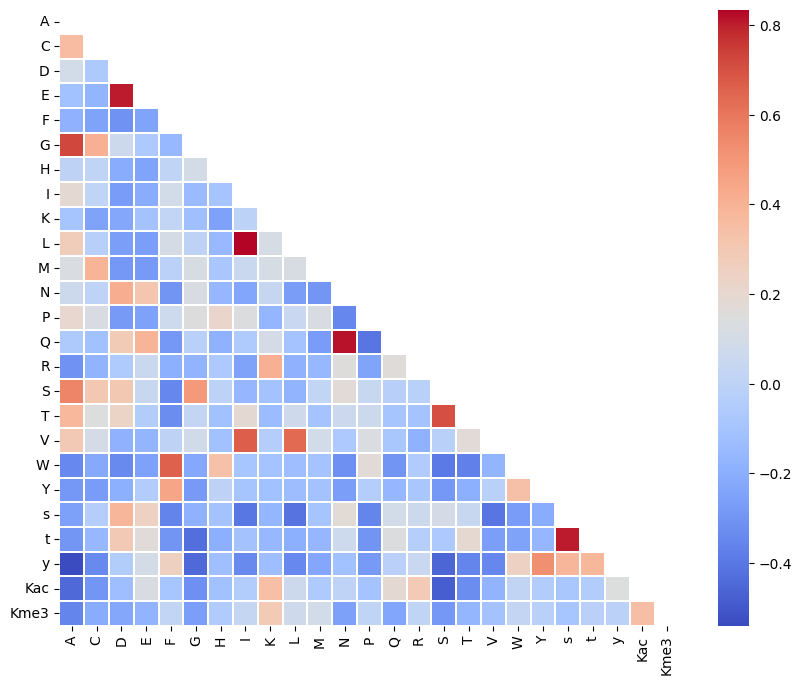
np.float64(0.872608302329996)Confusion matrix
plot_confusion_matrix
plot_confusion_matrix (target, pred, class_names:list=['0', '1'], normalize=False, title='Confusion matrix', cmap=<matplotlib.colors.LinearSegmentedColormap object at 0x7fb1d1b20ac0>)
Plot the confusion matrix.
| Type | Default | Details | |
|---|---|---|---|
| target | pd.Series | ||
| pred | pd.Series | ||
| class_names | list | [‘0’, ‘1’] | |
| normalize | bool | False | |
| title | str | Confusion matrix | |
| cmap | LinearSegmentedColormap | <matplotlib.colors.LinearSegmentedColormap object at 0x7fb1d1b20ac0> |
target = info.MW<160
pred = info.pKa1>2.1plot_confusion_matrix(target,pred,normalize=True)Normalized confusion matrix
Pie plot
plot_pie
plot_pie (value_counts, hue_order=None, labeldistance=0.8, fontsize=12, fontcolor='black', palette='tab20', figsize=(4, 3))
| Type | Default | Details | |
|---|---|---|---|
| value_counts | value counts | ||
| hue_order | NoneType | None | list of strings |
| labeldistance | float | 0.8 | |
| fontsize | int | 12 | |
| fontcolor | str | black | |
| palette | str | tab20 | |
| figsize | tuple | (4, 3) |
info=Data.get_kinase_info()plot_pie(info.modi_group.value_counts(),
fontsize=10,
labeldistance=1)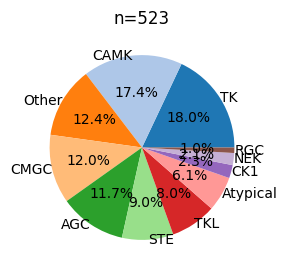
Bar composition
calculate_pct
calculate_pct (df, bin_col, hue_col)
Get percentage for hue in each bin; with hue adding up to 1 in each bin.
plot_composition
plot_composition (df, bin_col, hue_col, palette='tab20', legend_title=None, rotate=45, xlabel=None, ylabel='Percentage', figsize=(5, 3))
Plot bar count with value text
plot_cnt
plot_cnt (cnt, xlabel=None, ylabel='Count', figsize=(6, 3))